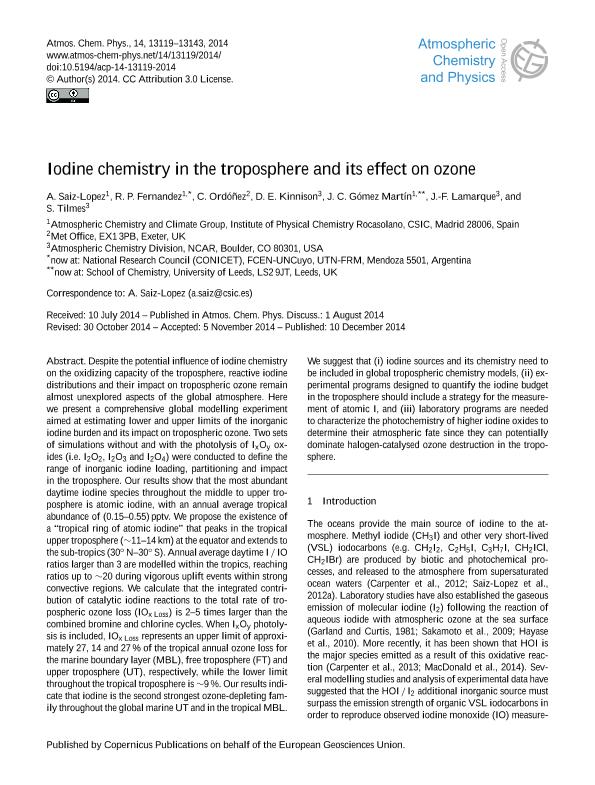Artículo
Iodine chemistry in the troposphere and its effect on ozone
Saiz-lopez, Alfonso; Fernandez, Rafael Pedro ; Ordóñez, C.; Kinnison, D.E.; Gómez, Martin J. C.; Lamarque, J. F.; Tilmes, Simone
; Ordóñez, C.; Kinnison, D.E.; Gómez, Martin J. C.; Lamarque, J. F.; Tilmes, Simone
 ; Ordóñez, C.; Kinnison, D.E.; Gómez, Martin J. C.; Lamarque, J. F.; Tilmes, Simone
; Ordóñez, C.; Kinnison, D.E.; Gómez, Martin J. C.; Lamarque, J. F.; Tilmes, Simone
Fecha de publicación:
12/2014
Editorial:
Copernicus Publications
Revista:
Atmospheric Chemistry and Physics
ISSN:
1680-7316
e-ISSN:
1680-7324
Idioma:
Inglés
Tipo de recurso:
Artículo publicado
Clasificación temática:
Resumen
Despite the potential influence of iodine chemistry on the oxidizing capacity of the troposphere, reactive iodine distributions and their impact on tropospheric ozone remain almost unexplored aspects of the global atmosphere. Here we present a comprehensive global modelling experiment aimed at estimating lower and upper limits of the inorganic iodine burden and its impact on tropospheric ozone. Two sets of simulations without and with the photolysis of IxOy oxides (i.e. I2O2, I2O3 and I2O4) were conducted to define the range of inorganic iodine loading, partitioning and impact in the troposphere. Our results show that the most abundant daytime iodine species throughout the middle to upper troposphere is atomic iodine, with an annual average tropical abundance of (0.15-0.55) pptv. We propose the existence of a "tropical ring of atomic iodine" that peaks in the tropical upper troposphere (∼11-14 km) at the equator and extends to the sub-tropics (30°N-30°S). Annual average daytime I = IO ratios larger than 3 are modelled within the tropics, reaching ratios up to ∼20 during vigorous uplift events within strong convective regions. We calculate that the integrated contribution of catalytic iodine reactions to the total rate of tropospheric ozone loss (IOx Loss) is 2-5 times larger than the combined bromine and chlorine cycles. When IxOy photolysis is included, IOx Loss represents an upper limit of approximately 27, 14 and 27% of the tropical annual ozone loss for the marine boundary layer (MBL), free troposphere (FT) and upper troposphere (UT), respectively, while the lower limit throughout the tropical troposphere is ∼9 %. Our results indicate that iodine is the second strongest ozone-depleting family throughout the global marine UT and in the tropical MBL. We suggest that (i) iodine sources and its chemistry need to be included in global tropospheric chemistry models, (ii) experimental programs designed to quantify the iodine budget in the troposphere should include a strategy for the measurement of atomic I, and (iii) laboratory programs are needed to characterize the photochemistry of higher iodine oxides to determine their atmospheric fate since they can potentially dominate halogen-catalysed ozone destruction in the troposphere.
Archivos asociados
Licencia
Identificadores
Colecciones
Articulos(CCT - MENDOZA)
Articulos de CTRO.CIENTIFICO TECNOL.CONICET - MENDOZA
Articulos de CTRO.CIENTIFICO TECNOL.CONICET - MENDOZA
Citación
Saiz-lopez, Alfonso; Fernandez, Rafael Pedro; Ordóñez, C.; Kinnison, D.E.; Gómez, Martin J. C.; et al.; Iodine chemistry in the troposphere and its effect on ozone; Copernicus Publications; Atmospheric Chemistry and Physics; 14; 23; 12-2014; 13119-13143
Compartir
Altmétricas



